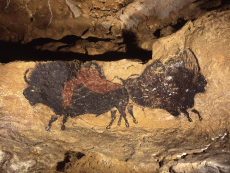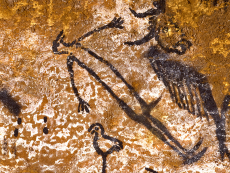
Lascaux is a set of caves which have some of the most well-preserved cave paintings in the world. Lascaux is located in the Vézère valley in south western France where there are an amazing 147 prehistoric sites and 25 decorated caves. It is hard to establish exactly how old the paintings are but there are clues. The paintings show many different large animals, and archaeologists have used their knowledge of when different species were alive to estimate when the paintings were done. The Lascaux paintings match with fossils found from the Upper Paleolithic period and so archaeologists estimate that they’re from around 17,000 years ago.
The caves were discovered in 1940 by 18-year-old Marcel Ravidat. He found the cave entrance on his own and then returned with three friends. The teenagers climbed through a long shaft or tunnel and found themselves in a series of caves of many different shapes and sizes. The walls and ceilings were all filled with over 600 paintings of bulls, horses, stags and other animals. Later when experts visited the caves they named each separate part: The Hall of the Bulls, The Axial Gallery, The Passageway, The Nave, Chamber of the Felines, The Apse and The Shaft.
The images were made using red, yellow and black pigments or paints made from different materials. Some of the pictures were made using brushes, while others were created with paint blown through tubes. In part of the caves where the rocks are softer the images have been carved in. Anthropologists, who study human beings throughout history, think that the images either show past successful hunting trips or were painted to bring good luck for hunting in the future.

The Hall of the Bulls is the most famous part of Lascaux and is the first section you come to. It is 20 metres long and filled with paintings of horses, cows, bulls and stags. It is named after four paintings of aurochs, a now extinct type of black bull. One of these is 5 metres long and is the largest single piece of cave art ever discovered. The Nave has a painting known as The Crossed Bison (pictured). It shows two bisons which are mirror images of each other, fleeing in opposite directions. The painting is particularly famous because one bull is painted on top of the other as though it is closer to the viewer and this shows a knowledge of perspective not often shown in cave paintings. The only painting of a human in the caves is found in The Shaft. A stick figure of a man is shown being attacked by a bison, with a small bird perched below (pictured). Many cultures give birds the role of ‘psychopomps’, which means they bring souls down to the underworld.
Eight years after their discovery the caves were opened to the public, and soon up to 1,200 people were visiting everyday. Unfortunately it wasn’t long before the heat and humidity began to damage the paintings, which had only been so well-preserved because they were sealed away for so long. In 1963 the caves were closed to the public and experts worked to restore the paintings, though sadly there is still a bad problem with mould. In 1983 a copy of the Great Hall of the Bulls was built nearby so people can experience what it’s like to be in the caves, but without destroying the paintings.
Images: http://www.lascaux.culture.fr

0 Comment:
Be the first one to comment on this article.